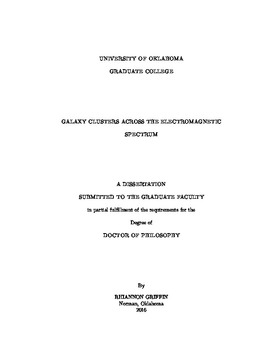| dc.description.abstract | Galaxy clusters are the largest gravitationally bound objects in the Universe.
From radio to X-ray, we have observed these objects across the electromagnetic
spectrum. Formation theories suggest that clusters even emit gamma-rays via
cosmic ray interactions with the hot intracluster gas. In this work, I will present
a brief overview of these observationally rich objects and then discuss methods
we have developed to observe galaxy clusters in the X-ray, optical and gamma-ray
regimes.
First, I will discuss our X-ray-selected catalog: the Swift AGN and Cluster
Survey. We use Swift X-ray Telescope data to locate extended X-ray sources as
galaxy cluster candidates. Swift GRB observations provide an excellent serendipitous, medium-depth, medium-area survey for both AGN (active galactic nuclei)
and galaxy clusters. In this work, I focus on the cluster source determination
method as well as the initial optical follow-up of cluster candidates. 203 of the
442 extended sources are located in the SDSS footprint and we confirm 104 to
be galaxy clusters. We report their redshifts and other cluster details. Additionally, we find that our catalog agrees well with similar studies in number counts,
redshift, scaling relations and observed red sequences.
Furthermore, I discuss our search for the elusive gamma-ray signal from galaxy
clusters theorized to be produced via neutral pion decay. Evidence suggests that
galaxy clusters are massive reservoirs of relativistic particles known as cosmic
rays. Cosmic ray protons interact with intracluster medium protons, resulting in
hadronic debris that includes gamma-rays. Although studies predict that with
today’s gamma-ray missions we should be able to observe this signal from clusters,
as of 2016, it has yet to be discovered. To this end, we develop a method for
stacking Fermi gamma-ray count maps and use this on a rich sample of 2MASS-
selected galaxy clusters. Although we do not observe a significant signal from the
final stack, we derive the lowest upper limits to date. We discuss the implications
to cosmology and large scale structure formation theories.
We update the Fermi stacking method to observe luminous and ultraluminous
infrared galaxies (LIRGs and ULIRGs) in the gamma-ray regime. The dense
interstellar medium and high star formation rates of these galaxies make them
ideal candidates for gamma-ray emission from neutral pion production. In the
appendix of this work, I present the details of our updated method and discuss
our results. Although, we do not observe a significant signal from the final stack
of galaxies, we place constraints that agree well with expectations. Furthermore,
we report the first gamma-ray detection of an ULIRG: a 4.3σ signal from Arp 220,
the closest ULIRG to Earth. We discuss the implications to galaxy formation and
compare our results to similar studies. | en_US |
